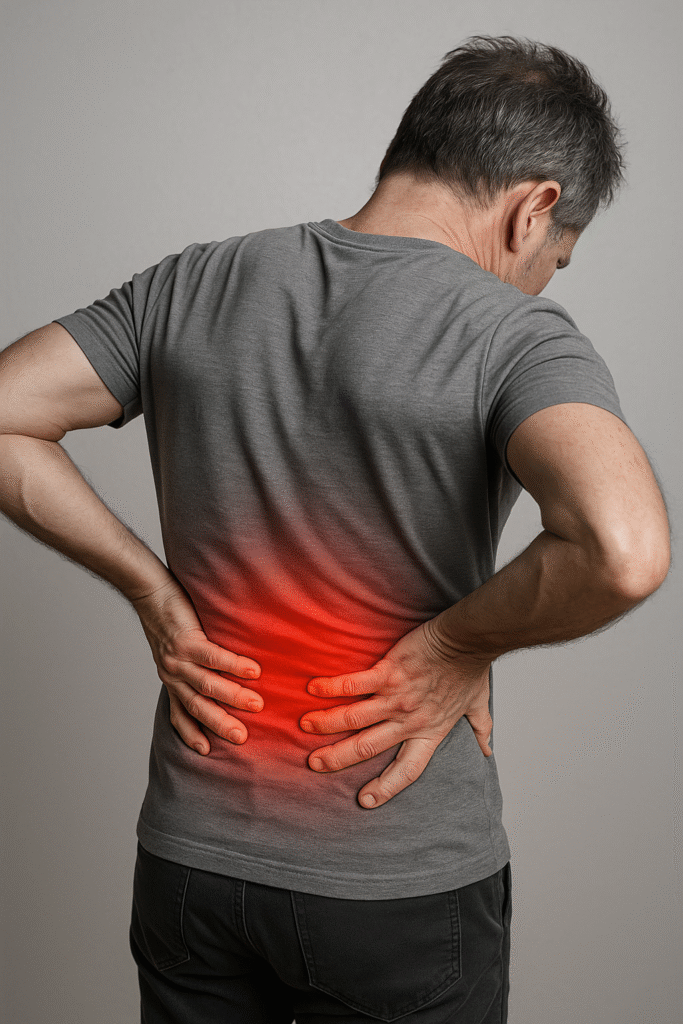Let’s be honest—most of us spend countless hours sitting at a desk, staring at a screen, rarely stopping to think about how our posture might be affecting our bodies. Over time, this can lead to one of the most common complaints in the workplace: back pain.
But the good news is that small changes in your daily habits can make a big difference. In this post, we’ll explore why back pain happens at work, and what evidence-based strategies you can implement to prevent it.

Why does your back hurt at work?
Back pain is a multifactorial issue, but in work settings, some key contributors include:
- Prolonged static sitting
- Poor ergonomic setup (e.g. chair height, screen angle)
- Lack of physical activity
- Repetitive movements or awkward positions
According to the European Guidelines for the Management of Low Back Pain, mechanical factors like prolonged sitting and improper posture are major risk factors for developing chronic pain conditions, especially in office environments (1).
Tip 1: Set up your desk ergonomically
An ergonomic workstation can significantly reduce spinal stress. According to the Occupational Safety and Health Administration (OSHA), your:
- Feet should rest flat on the floor or on a footrest
- Knees should be at or below hip level
- Elbows should be close to your body and form a 90–120° angle
- Screen should be at eye level, about an arm’s length away
Pro tip: Use a lumbar support pillow if your chair lacks lower back support.
Tip 2: Move every 30 minutes
Evidence shows that taking short, frequent breaks to move can reduce musculoskeletal discomfort and fatigue (2). Even just standing up and stretching or walking around the office can activate key stabilizing muscles and prevent stiffness.
Set a timer or use a smartwatch reminder—your back will thank you!
Tip 3: Strengthen your core and stretch your spine
Low-impact exercises that target core strength and flexibility—such as yoga, pilates, or physiotherapy-based routines—can protect your spine and reduce recurrent back pain.
A Cochrane review concluded that exercise therapy is effective in decreasing pain intensity and improving physical function in chronic low back pain (3).
Recommended stretches:
- Cat-cow stretch
- Child’s pose
- Supine spinal twist
- Pelvic tilts
Tip 4: Manage stress
Surprisingly, emotional stress can worsen back pain. When stressed, we often unconsciously tense muscles, especially in the neck and lower back.
A 2020 meta-analysis found a strong correlation between psychosocial stressors and the onset or exacerbation of low back pain (4). Techniques like breathing exercises, mindfulness meditation, or just stepping away from the desk to clear your mind can make a real difference.
Tip 5: Consider a standing desk (but do it right)
Alternating between sitting and standing improves circulation and reduces spinal compression. However, standing all day is not the answer either.
Studies recommend a sit–stand ratio of 1:1 or 2:1 (5). Just remember to:
- Keep your knees slightly bent (not locked)
- Shift your weight occasionally
- Use an anti-fatigue mat
Conclusion: Small changes, lasting impact
Preventing back pain at work doesn’t require a gym membership or quitting your job—it’s about awareness, movement, and posture. By integrating just a few of these science-backed habits into your daily routine, you can improve your spinal health and overall wellbeing.
References
- van Tulder M, Becker A, Bekkering T, et al. (2006). European guidelines for the management of acute non-specific low back pain in primary care. Eur Spine J;15(Suppl 2)\:S169–S191. https://doi.org/10.1007/s00586-006-1071-2
- Hayden JA, van Tulder MW, Malmivaara AV, Koes BW. (2005). Exercise therapy for treatment of non-specific low back pain. Cochrane Database Syst Rev; (3)\:CD000335. https://doi.org/10.1002/14651858.CD000335.pub2
- Parry S, Straker L. (2013). The contribution of office work to sedentary behaviour associated risk. BMC Public Health;13:296. https://doi.org/10.1186/1471-2458-13-296
- Becker A, Held H, Redaelli M, et al. (2020). Back pain and stress – Psychosocial risk factors in the workplace. Int Arch Occup Environ Health;93(6):783–795. https://doi.org/10.1007/s00420-020-01534-3
- Karakolis T, Callaghan JP. (2014). The impact of sit–stand office workstations on worker discomfort and productivity: A review. Appl Ergon;45(3):799–806. https://doi.org/10.1016/j.apergo.2013.10.002
